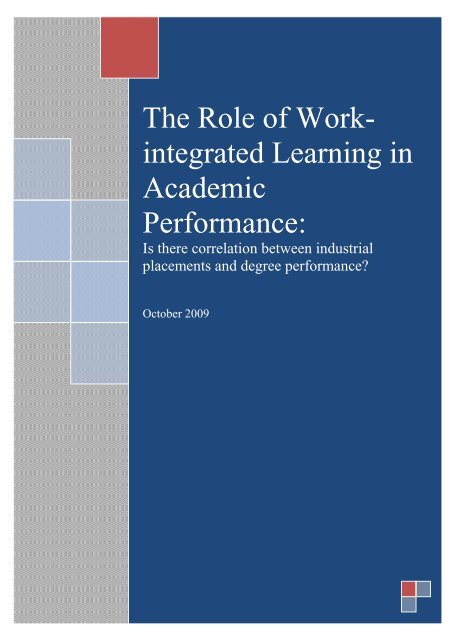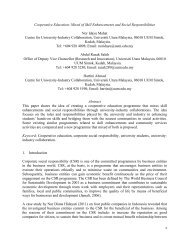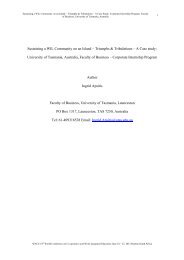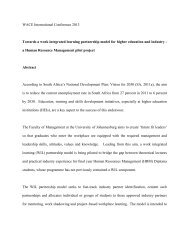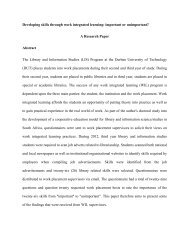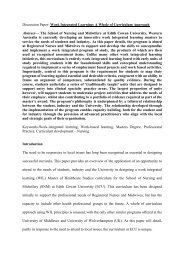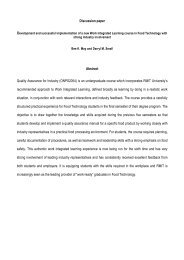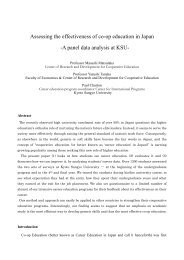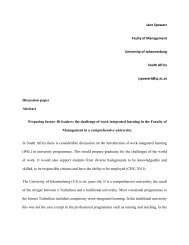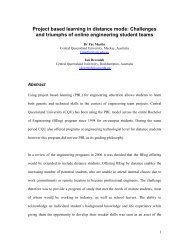The Role of Work-integrated Learning in Academic ... - WACE
The Role of Work-integrated Learning in Academic ... - WACE
The Role of Work-integrated Learning in Academic ... - WACE
You also want an ePaper? Increase the reach of your titles
YUMPU automatically turns print PDFs into web optimized ePapers that Google loves.
<strong>The</strong> <strong>Role</strong> <strong>of</strong> <strong>Work</strong><strong><strong>in</strong>tegrated</strong><br />
<strong>Learn<strong>in</strong>g</strong> <strong>in</strong><br />
<strong>Academic</strong><br />
Performance:<br />
Is there correlation between <strong>in</strong>dustrial<br />
placements and degree performance?<br />
October 2009
<strong>The</strong> <strong>Role</strong> <strong>of</strong> <strong>Work</strong>-<strong><strong>in</strong>tegrated</strong> <strong>Learn<strong>in</strong>g</strong> <strong>in</strong> <strong>Academic</strong><br />
Performance: Is there correlation between <strong>in</strong>dustrial<br />
placements and degree performance?<br />
Abstract<br />
<strong>The</strong> significance <strong>of</strong> <strong>in</strong>dustrial work placements (i.e. the work-based component <strong>of</strong> sandwich<br />
degrees) on students’ pr<strong>of</strong>essional development and employability is widely accepted<br />
amongst many work-related learn<strong>in</strong>g pr<strong>of</strong>essionals and academics alike. Indeed, the UK<br />
government-sponsored report by the Confederation <strong>of</strong> British Industry (CBI) validates such<br />
claims. However <strong>in</strong> recent times, many work-related learn<strong>in</strong>g pr<strong>of</strong>essionals have begun to<br />
explore the assumption that work placements not only improve employability skills, but also<br />
academic performance.<br />
This paper considers the view held by practitioners that students undertak<strong>in</strong>g an <strong>in</strong>dustrial<br />
work placement <strong>of</strong>ten graduate with a higher degree classification. This paper builds upon<br />
results from more comprehensive longitud<strong>in</strong>al research from Mandilaras (2004) and Gomez<br />
et al. (2004). It also builds upon the previous statistical research compiled by the author as <strong>of</strong><br />
2007/8, on a similar but larger cohort <strong>of</strong> students. However, on this occasion, the statistical<br />
analysis is more rigorous so as to ascerta<strong>in</strong> whether a true correlation exists between<br />
<strong>in</strong>dustrial placements and academic performance.<br />
Us<strong>in</strong>g statistical tools such as regression analysis and t-tests, this paper assesses the results <strong>of</strong><br />
an <strong>in</strong>stitutional study <strong>of</strong> eng<strong>in</strong>eer<strong>in</strong>g undergraduates at the University <strong>of</strong> Leicester, with the<br />
aim <strong>of</strong> explor<strong>in</strong>g whether there is a relationship between placement students and higher f<strong>in</strong>al<br />
degree results.<br />
<strong>The</strong> analysis <strong>of</strong>fers evidence that suggests an association between complet<strong>in</strong>g an <strong>in</strong>dustrial<br />
placement and achiev<strong>in</strong>g a higher degree result <strong>in</strong> the f<strong>in</strong>al year <strong>of</strong> an eng<strong>in</strong>eer<strong>in</strong>g degree.<br />
However, it also <strong>in</strong>dicates that there is another variable that has a greater impact on<br />
determ<strong>in</strong><strong>in</strong>g the degree result.<br />
Page 2
Introduction<br />
<strong>The</strong> presence <strong>of</strong> work-related learn<strong>in</strong>g and employability themes with<strong>in</strong> higher education has<br />
grown <strong>in</strong> prom<strong>in</strong>ence with the advent <strong>of</strong> successive government-backed reports. <strong>The</strong> most<br />
recent be<strong>in</strong>g ‘Future Fit: Prepar<strong>in</strong>g Graduates for the World <strong>of</strong> <strong>Work</strong>’, produced by the<br />
Confederation <strong>of</strong> British Industry Higher Education Task Force (2009) and sponsored by the<br />
Department for Innovation, Universities and Skills (DIUS). <strong>The</strong>se reports have encouraged<br />
the development <strong>of</strong> work-related learn<strong>in</strong>g activity (e.g. <strong>in</strong>dustrial placements) <strong>in</strong> higher<br />
education as a means by which to develop students’ employability and transferable skills.<br />
In light <strong>of</strong> such <strong>in</strong>terest, the correlation between <strong>in</strong>dustrial placements and students’<br />
employability has been comprehensively explored by practitioners such as Bowes & Harvey<br />
(1999) and Little & Harvey (2006) amongst others. However there rema<strong>in</strong>s a dearth <strong>of</strong><br />
current literature and research explor<strong>in</strong>g the correlation between placements and f<strong>in</strong>al degree<br />
atta<strong>in</strong>ment.<br />
Amongst the germane literature, research by Mayo & Jones (1985) and the Council for<br />
National <strong>Academic</strong> Awards (Davies, 2003) substantiate claims <strong>of</strong> correlation. Additionally,<br />
the Confederation <strong>of</strong> British Industry’s Higher Education Task Force (2009) reports on the<br />
analysis <strong>of</strong> research from the University <strong>of</strong> Hertfordshire that concluded with similar<br />
f<strong>in</strong>d<strong>in</strong>gs. <strong>The</strong> works <strong>of</strong> Mandilaras’ (2004) and Gomez et al (2004) explore this area <strong>in</strong><br />
greater depth. Us<strong>in</strong>g data from the Economics Department, University <strong>of</strong> Surrey, Mandilaras<br />
rigorously explores whether the <strong>in</strong>dustrial placement augments academic performance (i.e.<br />
<strong>in</strong>creas<strong>in</strong>g the likelihood <strong>of</strong> the placement student obta<strong>in</strong><strong>in</strong>g an upper second or first degree<br />
classification). Similarly, Gomez et al. <strong>in</strong>vestigate the impact <strong>of</strong> an <strong>in</strong>dustrial placement on<br />
Bioscience undergraduate performance at the University <strong>of</strong> the West <strong>of</strong> England, Bristol.<br />
Mandilaras’ study addresses a host <strong>of</strong> variables, <strong>in</strong>clud<strong>in</strong>g gender, nationality and prior study<br />
<strong>of</strong> mathematics and economics, that might otherwise underm<strong>in</strong>e any assertion about<br />
correlation. Moreover, Gomez et al.’s study meticulously takes <strong>in</strong>to account variables such<br />
as gender, pre-university qualifications and level 1, 2 and 3 aggregate marks (as percentages).<br />
Both studies suggest a correlation between placements and f<strong>in</strong>al degree results. Mandilaras<br />
concludes that<br />
Page 3
‘the statistical analysis <strong>of</strong>fers evidence that participation <strong>in</strong> the placement scheme<br />
significantly <strong>in</strong>creases the chances <strong>of</strong> obta<strong>in</strong><strong>in</strong>g an upper second or higher degree class’<br />
(Mandilaras, 2004, p.39).<br />
Whilst Gomez et al comment that<br />
‘On average, placement students ga<strong>in</strong> an advantage <strong>of</strong> nearly 4% <strong>in</strong> their f<strong>in</strong>al year<br />
performance’ (Gomez et al., 2004, p.373).<br />
In explor<strong>in</strong>g the possibility <strong>of</strong> correlation, this paper compares the f<strong>in</strong>al degree results <strong>of</strong><br />
eng<strong>in</strong>eer<strong>in</strong>g placement students with those <strong>of</strong> their non-placement counterparts at the<br />
University <strong>of</strong> Leicester. <strong>The</strong> analysis section discusses these results and their implications.<br />
Background: Eng<strong>in</strong>eer<strong>in</strong>g at the University <strong>of</strong> Leicester<br />
<strong>The</strong> Department <strong>of</strong> Eng<strong>in</strong>eer<strong>in</strong>g at the University <strong>of</strong> Leicester is one <strong>of</strong> the largest<br />
departments <strong>in</strong> the University with approximately 500 undergraduate and postgraduate<br />
students and researchers, 40 academic staff and 30 support staff.<br />
<strong>The</strong> Department has a well-established <strong>in</strong>dustrial placement programme giv<strong>in</strong>g<br />
undergraduates the opportunity to embark upon a full year <strong>in</strong> <strong>in</strong>dustry with<strong>in</strong> the follow<strong>in</strong>g<br />
degree programmes:<br />
• General Eng<strong>in</strong>eer<strong>in</strong>g<br />
• Mechanical Eng<strong>in</strong>eer<strong>in</strong>g<br />
• Electrical and Electronic Eng<strong>in</strong>eer<strong>in</strong>g<br />
• Communications and Electronic Eng<strong>in</strong>eer<strong>in</strong>g<br />
• Embedded Systems Eng<strong>in</strong>eer<strong>in</strong>g<br />
Each degree has a Bachelor <strong>of</strong> Eng<strong>in</strong>eer<strong>in</strong>g (BEng) course option, with three years <strong>of</strong> study at<br />
university, and a Master <strong>of</strong> Eng<strong>in</strong>eer<strong>in</strong>g (MEng) course option, with four years <strong>of</strong> study at<br />
university. <strong>The</strong> Master course satisfies the academic requirements for <strong>in</strong>corporation as<br />
Page 4
Chartered Eng<strong>in</strong>eer from the Eng<strong>in</strong>eer<strong>in</strong>g Council. <strong>The</strong> Eng<strong>in</strong>eer<strong>in</strong>g Department has longstand<strong>in</strong>g<br />
relationships with a host <strong>of</strong> eng<strong>in</strong>eer<strong>in</strong>g employers who have <strong>of</strong>fered placements to<br />
Leicester students. Past students have taken up <strong>in</strong>dustrial work placements with a host <strong>of</strong><br />
blue-chip employers such as Toyota, Corus and Caterpillar. Students are assessed on the basis<br />
<strong>of</strong> an <strong>in</strong>dustrial placement report that must be submitted on completion <strong>of</strong> the placement. This<br />
assessment is marked on a pass/fail basis.<br />
Methodology<br />
Description <strong>of</strong> the dataset<br />
<strong>The</strong> quantitative study ma<strong>in</strong>ta<strong>in</strong>s a comparable level <strong>of</strong> scrut<strong>in</strong>y to that <strong>of</strong> Mandilaras’ work<br />
<strong>in</strong> so much that it takes <strong>in</strong>to consideration important variables. Firstly, it scrut<strong>in</strong>ises the varied<br />
academic abilities <strong>of</strong> students by account<strong>in</strong>g for their year 1 and year 2 aggregate marks (as<br />
percentages) from the degree. Secondly, it factors <strong>in</strong> the level <strong>of</strong> study undertaken (those<br />
tak<strong>in</strong>g degrees at BEng or MEng level). Thirdly, it explores the eng<strong>in</strong>eer<strong>in</strong>g discipl<strong>in</strong>es<br />
studied (e.g. Mechanical Eng<strong>in</strong>eer<strong>in</strong>g, Embedded Systems, Electrical Eng<strong>in</strong>eer<strong>in</strong>g etc).<br />
<strong>The</strong> output variable was the year 3 degree aggregate results and the comparisons <strong>of</strong> these<br />
results between the cohort <strong>of</strong> students who undertook a year <strong>in</strong> <strong>in</strong>dustry versus those who did<br />
not. <strong>The</strong> rationale for scrut<strong>in</strong>is<strong>in</strong>g year 3 aggregate marks relates to the fact that these are the<br />
results atta<strong>in</strong>ed by students directly after the completion <strong>of</strong> the year <strong>in</strong> <strong>in</strong>dustry. As such, by<br />
compar<strong>in</strong>g the year 3 aggregate marks between placement students and their non-placement<br />
counterparts, one can reasonably assume that any difference <strong>in</strong> atta<strong>in</strong>ment is directly related<br />
to the experience <strong>of</strong> a year-long placement. Naturally, it would be naive to assume the<br />
placement element could be the only factor <strong>in</strong> atta<strong>in</strong>ment between the two cohorts. This is<br />
why this study utilises other variables.<br />
A frequent criticism levelled at research <strong>of</strong> this nature is the notion that students undertak<strong>in</strong>g<br />
a placement year are already high achievers; hence their degree performance has less to do<br />
with their <strong>in</strong>dustrial year placement, and more to do with their previous academic<br />
performance. This study has attempted to counter such claims by <strong>in</strong>clud<strong>in</strong>g a spectrum <strong>of</strong> first<br />
Page 5
year atta<strong>in</strong>ment marks (both high and low marks <strong>in</strong> both groups <strong>of</strong> students) to counter<br />
skewed results.<br />
<strong>The</strong> f<strong>in</strong>al variable was medical evidence. This translates as students who suffered extenuat<strong>in</strong>g<br />
circumstances such as a bereavement or exceptional f<strong>in</strong>ancial hardship or any other personal<br />
and psychological factors that might <strong>in</strong>terfere with their ability to achieve a good f<strong>in</strong>al degree<br />
result.<br />
Statistical Approach<br />
For this research, the statistical tools utilised were t-tests and a number <strong>of</strong> regressions.<br />
Dist<strong>in</strong>ctions between placement student from that <strong>of</strong> non-placement students <strong>in</strong> the statistical<br />
analysis were made on the basis <strong>of</strong> standard variable codes where 0= non-placement and 1 =<br />
placement.<br />
<strong>The</strong> variables utilised for the t-test were that <strong>of</strong> placement versus non-placement students and<br />
the output data (the correspond<strong>in</strong>g year 3 aggregate marks for each <strong>of</strong> the students). In the<br />
regressions, all 7 variables were <strong>in</strong>cluded as seen <strong>in</strong> table 1.<br />
Page 6
Table 1 illustrates all the variables accounted for <strong>in</strong> the research methodology.<br />
Variable number Variable description Regression analysis output or<br />
<strong>in</strong>put<br />
1 Year 3 degree aggregate<br />
marks (%)<br />
2 Year 1 degree aggregate<br />
marks (%)<br />
3 Year 2 degree aggregate<br />
marks (%)<br />
Output<br />
Input<br />
Input<br />
4 Degree level: BEng or MEng Input<br />
5 Placement student vs. nonplacement<br />
student<br />
6 Eng<strong>in</strong>eer<strong>in</strong>g discipl<strong>in</strong>e (e.g.<br />
Mechanical, Embedded<br />
Systems etc).<br />
Input<br />
Input<br />
7 Medical evidence Input<br />
Population Sample<br />
<strong>The</strong> population sampled comprised <strong>of</strong> the 2008 cohort <strong>of</strong> Eng<strong>in</strong>eer<strong>in</strong>g f<strong>in</strong>alists and MEng<br />
pre-f<strong>in</strong>alists; this provided a sample size approach<strong>in</strong>g 60 students (58). Whilst acknowledg<strong>in</strong>g<br />
that this sample size was smaller than that <strong>of</strong> Gomez et al. (164 students), Mandilaras (124<br />
students) and <strong>in</strong>deed our own earlier study over 2007/8 (80 students), the work aimed to build<br />
upon our exist<strong>in</strong>g study and scrut<strong>in</strong>ise a s<strong>in</strong>gle year cohort (2008) us<strong>in</strong>g more sophisticated<br />
statistical techniques (t-tests and regression analysis).<br />
<strong>The</strong> number <strong>of</strong> the sample population undertak<strong>in</strong>g a placement was 19, compared with 39<br />
who were not undertak<strong>in</strong>g a placement. In both groups, there was a fair representation <strong>of</strong><br />
prior atta<strong>in</strong>ment. That is to say those whose prior atta<strong>in</strong>ment average equated to a 2.2 (50%<br />
Analysis<br />
<strong>The</strong> t-test provided a breakdown <strong>of</strong> the group statistics; namely the mean average aggregate<br />
year 3 marks <strong>of</strong> placement students (as a group) and non-placement students (as a group).<br />
<strong>The</strong> t-test also tested the significance <strong>of</strong> the results.<br />
Table 2 (i) and (ii) illustrates the results ga<strong>in</strong>ed from the t-test.<br />
Table 2 (i)<br />
Placement (1) vs. nonplacement<br />
(0)<br />
Group number<br />
Group mean year 3 marks as<br />
%<br />
Variable 1 (yr 3 mark) 0<br />
1<br />
39<br />
19<br />
60.3359<br />
71.5842<br />
Table 2 (ii)<br />
Variance assumptions<br />
Equal variances assumed<br />
Equal variances not assumed<br />
T-test for Equality <strong>of</strong> Means<br />
Significance (2-tailed)<br />
0.004<br />
0.001<br />
<strong>The</strong> purpose for us<strong>in</strong>g the t-test was to test the difference <strong>of</strong> the means <strong>of</strong> the two groups<br />
(placement students and non-placement students). <strong>The</strong> null hypothesis for this study assumes<br />
that the two groups’ year 3 atta<strong>in</strong>ment/marks are roughly the same. <strong>The</strong>refore it suggests that<br />
a placement will not improve academic performance.<br />
From table 2 (i) it is observed that non-placement students’ (group 0) mean average year 3<br />
marks were 60%, whilst placement students’ (group 1) averaged 71%. This illustrates a clear<br />
11% difference <strong>in</strong> favour <strong>of</strong> placement students. However to assess whether these results are<br />
significant from a probability sense and not just a co<strong>in</strong>cidence, the equality <strong>of</strong> means aspect<br />
Page 8
<strong>of</strong> the t-test needs to be scrut<strong>in</strong>ised. Us<strong>in</strong>g the ‘equal variances assumed’ category (i.e. the<br />
null hypothesis), the 2-tailed significance p-value is 0.004. This result suggests strong<br />
significance as it is drastically below 0.05; 0.05 be<strong>in</strong>g the cut-<strong>of</strong>f po<strong>in</strong>t that <strong>in</strong>dicates strong<br />
significance. <strong>The</strong>refore the t-test suggests that the null hypothesis should be rejected, as the<br />
result <strong>in</strong>dicates that there is a genu<strong>in</strong>e difference <strong>in</strong> the atta<strong>in</strong>ment <strong>of</strong> the two groups, which<br />
cannot be expla<strong>in</strong>ed by pure chance or co<strong>in</strong>cidence alone.<br />
However the t-test did not account for other variables that might impact year 3 atta<strong>in</strong>ment.<br />
For this reason, a regression analysis was conducted to factor <strong>in</strong> other variables. <strong>The</strong><br />
regression results reported <strong>in</strong> table 3 show that two variables were significant. Variable 3<br />
represented year 2 degree aggregate marks. Accord<strong>in</strong>g to the regression analysis, this variable<br />
was the s<strong>in</strong>gle most significant <strong>in</strong>dicator <strong>of</strong> likely year 3 academic performance. A p-value <strong>of</strong><br />
0.00 was given.<br />
Variable 5 represented placement students versus non-placement students. A p-value <strong>of</strong> 0.12<br />
was given. Whilst this falls short <strong>of</strong> the 0.05 cut-<strong>of</strong>f po<strong>in</strong>t <strong>of</strong> strong significance, it is close<br />
enough to suggest that some significance exists, but to a lesser extent than year 2 degree<br />
aggregate marks (variable 3). As such, both the t-tests and the regressions seem to conclude<br />
some degree <strong>of</strong> positive association between tak<strong>in</strong>g an <strong>in</strong>dustrial placement and degree<br />
performance <strong>in</strong> the f<strong>in</strong>al year. Whilst the rigour <strong>of</strong> the regression suggests that year 2 result is<br />
the most important factor, nonetheless the regression concurs that <strong>in</strong>dustrial placements have<br />
an impact also. <strong>The</strong>se f<strong>in</strong>d<strong>in</strong>gs seem to corroborate earlier studies. <strong>The</strong> other variables<br />
appeared to have little/no significance <strong>in</strong> determ<strong>in</strong><strong>in</strong>g year 3 academic performance.<br />
An area that has not been previously explored is the relationship between extenuat<strong>in</strong>g<br />
circumstances and students do<strong>in</strong>g a year <strong>in</strong> <strong>in</strong>dustry. This study did not sample a large enough<br />
number <strong>of</strong> students encounter<strong>in</strong>g extenuat<strong>in</strong>g circumstances, and as such any conclusions<br />
drawn are very limited. However the results encourage further exploration <strong>in</strong> this area as the<br />
regression analysis suggested no significant or detrimental impact <strong>in</strong> atta<strong>in</strong>ment by students<br />
who encountered extenuat<strong>in</strong>g circumstances. This was the case for those who undertook a<br />
year <strong>in</strong> <strong>in</strong>dustry as well as those who did not. This might po<strong>in</strong>t to a host <strong>of</strong> plausible<br />
Page 9
explanations. For example, the University’s pastoral support/counsell<strong>in</strong>g service is <strong>of</strong> good<br />
quality and thus enables the student to succeed at their studies <strong>in</strong> spite <strong>of</strong> challeng<strong>in</strong>g<br />
circumstances. However, at this <strong>in</strong>terval no further analysis <strong>of</strong> these results will be explored<br />
as this sub-aspect <strong>of</strong> the research warrants a separate <strong>in</strong>dependent study from that which is<br />
be<strong>in</strong>g <strong>in</strong>vestigated <strong>in</strong> this paper.<br />
Table 3 illustrates the results ga<strong>in</strong>ed from the regression.<br />
Variable description<br />
P-value (Significance)<br />
Year 3 degree aggregate marks (%) 0.58<br />
Year 1 degree aggregate marks (%) 0.47<br />
Year 2 degree aggregate marks (%) *0.00<br />
Degree level: BEng or MEng 0.18<br />
Placement student vs. non-placement student<br />
□□0.12<br />
Eng<strong>in</strong>eer<strong>in</strong>g discipl<strong>in</strong>e 0.17<br />
Medical evidence 0.42<br />
(* below 0.05 = strong significance, □□ below 0.15 = significance)<br />
Discussion<br />
Hav<strong>in</strong>g determ<strong>in</strong>ed statistically the significance <strong>of</strong> complet<strong>in</strong>g an <strong>in</strong>dustrial placement on<br />
academic performance, there is justification <strong>in</strong> explor<strong>in</strong>g the possible causes <strong>of</strong> this result.<br />
<strong>The</strong> Confederation <strong>of</strong> British Industry’s Higher Education Task Force (2009) stresses the<br />
significance <strong>of</strong> improved student confidence result<strong>in</strong>g from a year <strong>in</strong> <strong>in</strong>dustry. In their report<br />
they claim<br />
‘<strong>in</strong>creased confidence is widely mentioned by universities, employers and students as a<br />
beneficial outcome <strong>of</strong> work-related learn<strong>in</strong>g and formal work placements’ (Confederation <strong>of</strong><br />
British Industry, 2009, p.17).<br />
Page<br />
10
However this does not fully expla<strong>in</strong> why a work placement student should go on to atta<strong>in</strong> a<br />
better degree result. Others have postulated that metacognition (learn<strong>in</strong>g to learn) is<br />
responsible for the improved performance <strong>of</strong> the student return<strong>in</strong>g to their f<strong>in</strong>al year <strong>of</strong> study<br />
after their placement. Rael<strong>in</strong> (2000) identifies metacognition as an <strong>in</strong>herent value-added trait<br />
<strong>of</strong> work-based learn<strong>in</strong>g. It is possible that the nature and environment <strong>of</strong> an <strong>in</strong>dustrial work<br />
placement (and contact with pr<strong>of</strong>essional work colleagues) <strong>in</strong>stils the meta-cognitive skills<br />
necessary for personal reflection, development and enriched <strong>in</strong>dependent learn<strong>in</strong>g. <strong>The</strong>refore,<br />
on return<strong>in</strong>g to university, the student transfers this new approach to her/his studies and<br />
excels.<br />
Wallace (2002) deliberates over possible causes list<strong>in</strong>g several possible reasons, <strong>in</strong>clud<strong>in</strong>g<br />
those undertak<strong>in</strong>g a placement already hav<strong>in</strong>g a different temperament and higher aspirations<br />
to beg<strong>in</strong> with. He also postulates whether the year <strong>in</strong> <strong>in</strong>dustry alleviates the f<strong>in</strong>ancial burdens,<br />
thus enabl<strong>in</strong>g the return<strong>in</strong>g student to focus purely on one’s studies <strong>in</strong> their f<strong>in</strong>al year.<br />
Another hypothesis is that put forth by Mandilaras (2004). Mandilaras identifies some<br />
potential explanations for the improved academic atta<strong>in</strong>ment <strong>of</strong> return<strong>in</strong>g placement students.<br />
In his paper he asserts<br />
‘it is possible that the placement experience enables the students to mature more quickly<br />
than they otherwise would. Spend<strong>in</strong>g a year work<strong>in</strong>g <strong>in</strong> <strong>of</strong>ten competitive environments makes<br />
them realise that their future pr<strong>of</strong>essional development is to an extent, related to their<br />
academic performance. Hence their ambition is stimulated, they come back to university<br />
more focused and determ<strong>in</strong>ed to do well’ (Mandilaras, 2004, p.48).<br />
Clearly, there is a level <strong>of</strong> credibility associated with this hypothesis. Anecdotal evidence<br />
aside, the belief that a student fully immersed <strong>in</strong> a pr<strong>of</strong>essional work context for the duration<br />
<strong>of</strong> a year might then return to their studies with a more mature outlook is highly plausible.<br />
Additionally, Gomez et al. (2004) provide further <strong>in</strong>sights that might expla<strong>in</strong> this<br />
phenomenon. Gomez et al. postulate<br />
‘One simple factor that may be important is that students return<strong>in</strong>g from placement are<br />
tackl<strong>in</strong>g the rigours <strong>of</strong> the level 3 study one year older than they would otherwise be’ (Gomez<br />
et al., 2004, p.382).<br />
Page<br />
11
Here Gomez et al. suggests the academic improvement <strong>of</strong> the placement student may stem<br />
from the fact that the placement student will be complet<strong>in</strong>g their f<strong>in</strong>al year studies a year<br />
later. <strong>The</strong> assumption is that the older student is better equipped to perform well <strong>in</strong> the f<strong>in</strong>al<br />
year <strong>of</strong> their degree than their younger, non-placement counterparts. Gomez et al. goes on to<br />
say<br />
‘Quite <strong>of</strong>ten, a placement student undertakes a f<strong>in</strong>al year research project <strong>in</strong> a completely<br />
different area to that experienced dur<strong>in</strong>g their placement, although some....skills will be<br />
generic. <strong>The</strong>refore, it is more likely that the generic skills <strong>of</strong> team-work<strong>in</strong>g, communication,<br />
self-reliance and confidence, time keep<strong>in</strong>g, etc., transfer to their approach to the project.<br />
Placement students may also benefit from see<strong>in</strong>g the practical applications <strong>of</strong> their studies<br />
outside the academic world and therefore relate to their studies with a greater <strong>in</strong>sight<br />
(Gomez et al., 2004, p.382).<br />
<strong>The</strong> <strong>in</strong>sights provided by Mandilaras and Gomez et al. are supported by other areas <strong>of</strong><br />
research that scrut<strong>in</strong>ise the relationship between <strong>in</strong>dustrial placements and<br />
transferable/employability skills. For example, Knight & Yorke (2004) refer to the survey<br />
that sought the views <strong>of</strong> employers and recently appo<strong>in</strong>ted graduate employees. <strong>The</strong> f<strong>in</strong>d<strong>in</strong>gs<br />
from this study suggests overwhelm<strong>in</strong>g consensus from both cohorts that work placements<br />
are a major factor <strong>in</strong> the development <strong>of</strong> transferable skills and personal development. It is<br />
not difficult to recognise that the application <strong>of</strong> skills needed <strong>in</strong> a pr<strong>of</strong>essional work<br />
environment may cross over to those necessary to excel <strong>in</strong> academia. Indeed, it has been<br />
reported by eng<strong>in</strong>eer<strong>in</strong>g academic staff at the University <strong>of</strong> Leicester that students return<strong>in</strong>g<br />
from a year <strong>in</strong> <strong>in</strong>dustry display an enhanced level <strong>of</strong> maturity, focus and generic skills, thus<br />
giv<strong>in</strong>g some weight to the hypothesises put forth by Mandilaras and Gomez et al.<br />
Whilst caution must be exercised concern<strong>in</strong>g the results <strong>of</strong> this study, due to the dataset size<br />
on which they are based, these f<strong>in</strong>d<strong>in</strong>gs <strong>in</strong> conjunction with those <strong>of</strong> Gomez et al, Mandilaras<br />
and <strong>in</strong>deed Wallace (2002) give support for the presence and further development <strong>of</strong> workbased<br />
learn<strong>in</strong>g elements <strong>in</strong> the curricula <strong>of</strong> universities, not only as a means by which to<br />
enhance students’ employability, but also as a mechanism by which to possibly augment<br />
academic learn<strong>in</strong>g.<br />
Page<br />
12
Conclusion<br />
By utilis<strong>in</strong>g data from the University <strong>of</strong> Leicester’s Department <strong>of</strong> Eng<strong>in</strong>eer<strong>in</strong>g, this paper<br />
has exam<strong>in</strong>ed the efficacy <strong>of</strong> <strong>in</strong>dustrial work placements on improv<strong>in</strong>g academic performance<br />
amongst eng<strong>in</strong>eer<strong>in</strong>g students. Evidently, the f<strong>in</strong>d<strong>in</strong>gs illustrate a positive association<br />
between placements and improved academic performance whilst also suggest<strong>in</strong>g that year 2<br />
academic performance is a better <strong>in</strong>dicator <strong>of</strong> likely academic performance. <strong>The</strong> robustness <strong>of</strong><br />
the statistical evidence is credible, given the use <strong>of</strong> statistical methods such as t-tests and<br />
regressions. However, the study is limited by the sample size. A sample population<br />
approach<strong>in</strong>g 60 students leaves a larger marg<strong>in</strong> for error than a larger population size <strong>of</strong> say<br />
105 plus, when conduct<strong>in</strong>g research <strong>of</strong> this nature. As such, whilst the rigour and methods<br />
adopted are highly credible, one acknowledges that a larger population size is required <strong>in</strong><br />
future to strengthen claims <strong>of</strong> correlation.<br />
Limitations aside, the f<strong>in</strong>d<strong>in</strong>gs from this research and that <strong>of</strong> other researchers provides<br />
justification for the presence <strong>of</strong> quality-assured <strong>in</strong>dustrial work placements <strong>in</strong> academia, as<br />
such programmes not only augment the employability <strong>of</strong> the student, but they also enhance<br />
their maturity and academic prowess.<br />
References<br />
Atlay, M. & Harris, R. (2000) An Institutional Approach to Develop<strong>in</strong>g Students',<br />
Innovations <strong>in</strong> Education and Tra<strong>in</strong><strong>in</strong>g International, 37: p76-81<br />
Bowes, L. & Harvey, L. (1999) <strong>The</strong> Impact <strong>of</strong> Sandwich Education on the Activities <strong>of</strong><br />
Graduates Six Months Post-Graduation, Birm<strong>in</strong>gham: Centre for Research <strong>in</strong>to Quality.<br />
Confederation <strong>of</strong> British Industry (2009) Future Fit: Prepar<strong>in</strong>g Graduates for the World <strong>of</strong><br />
<strong>Work</strong>, London: Confederation <strong>of</strong> British Industry Higher Education Task Force.<br />
Davies, L. (2003) Experience-based <strong>Learn<strong>in</strong>g</strong> with<strong>in</strong> the Curriculum – a synthesis study,<br />
Sheffield: Association for Sandwich Education and Tra<strong>in</strong><strong>in</strong>g.<br />
Page<br />
13
Gomez, S., Lush, D. & Clements, M. (2004) <strong>Work</strong> Placements Enhance the <strong>Academic</strong><br />
Performance <strong>of</strong> Bioscience Undergraduates, Journal <strong>of</strong> Vocational Education and Tra<strong>in</strong><strong>in</strong>g,<br />
vol. 56, no 3, pp. 373-386.<br />
Higher Education Group (2008) Higher Education at <strong>Work</strong>: high skills, high value, Sheffield:<br />
Department for Innovation, Universities and Skills.<br />
Kemp, I. & Seagraves, L. (1995) Transferable Skills – Can Higher Education Deliver?<br />
Studies <strong>in</strong> Higher Education, 20: 3, pp315-328.<br />
Knight, P. & Yorke, M. (2004) <strong>Learn<strong>in</strong>g</strong>, Curriculum and Employability <strong>in</strong> Higher<br />
Education, London: RoutledgeFalmer.<br />
Knight, P. & Yorke, M. (2004) Embedd<strong>in</strong>g Employability <strong>in</strong>to the Curriculum, York: Higher<br />
Education Authority.<br />
Little, B. & Harvey, L. (2006) <strong>Learn<strong>in</strong>g</strong> Through <strong>Work</strong> Placements and Beyond, Sheffield:<br />
Centre for Research and Evaluation.<br />
Mandilaras, A. (2004) Industrial Placement and Degree Performance: Evidence from a<br />
British Higher Institution, International Review <strong>of</strong> Economics Education, vol. 3, no. 1, pp.<br />
39-51.<br />
Mayo, R. & Jones, and L. (1985) Proceed<strong>in</strong>gs <strong>of</strong> the Fourth World Conference on Cooperative<br />
Education, pp 428-31, Ed<strong>in</strong>burgh: Napier College.<br />
Moreland, N. (2005) <strong>Work</strong>-related <strong>Learn<strong>in</strong>g</strong> <strong>in</strong> Higher Education, York: Higher Education<br />
Authority.<br />
Nixon, I., Smith, K., Stafford, R. & Camm, S. (2006) <strong>Work</strong>-based <strong>Learn<strong>in</strong>g</strong>: Illum<strong>in</strong>at<strong>in</strong>g the<br />
higher education landscape, York: <strong>The</strong> Higher Education Academy<br />
Rael<strong>in</strong>, J. (2000) <strong>Work</strong>-based <strong>Learn<strong>in</strong>g</strong>: <strong>The</strong> New Frontier <strong>of</strong> Management Development,<br />
New Jersey: Prentice Hall.<br />
Tariq, V. & Cochrane, C. (2003) Reflections on Key Skills: implement<strong>in</strong>g change <strong>in</strong> a<br />
traditional university, Journal <strong>of</strong> Education Policy, 18:5, pp481-498.<br />
Toml<strong>in</strong>son, M. (2007) Graduate Employability and Student Attitudes and Orientations to the<br />
Labour Market, Journal <strong>of</strong> Education and <strong>Work</strong>, 20:4, pp.285-304.<br />
Page<br />
14
Toml<strong>in</strong>son, M. (2008) <strong>The</strong> Degree is Not Enough: students’ perceptions <strong>of</strong> the role <strong>of</strong> higher<br />
education credentials for graduate work and employability’, British Journal <strong>of</strong> Sociology <strong>of</strong><br />
Education, 29:1, pp49-61.<br />
Wallace, R. (2002) A Sandwich Year Can Seriously Damage Your Chances <strong>of</strong> Obta<strong>in</strong><strong>in</strong>g a<br />
Poor Degree, ASET European Conference – Integrat<strong>in</strong>g <strong>Work</strong> and <strong>Learn<strong>in</strong>g</strong> <strong>in</strong> Europe,<br />
Cambridge: ASET<br />
Page<br />
15


